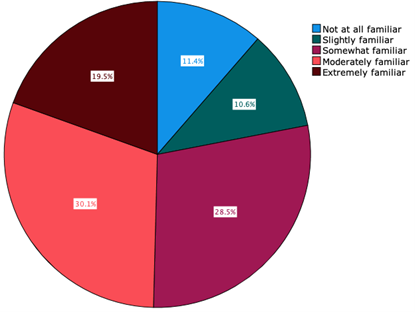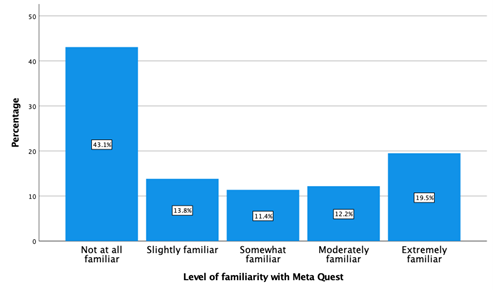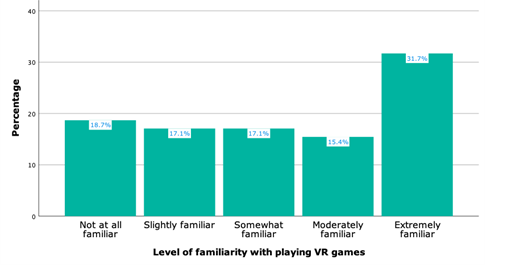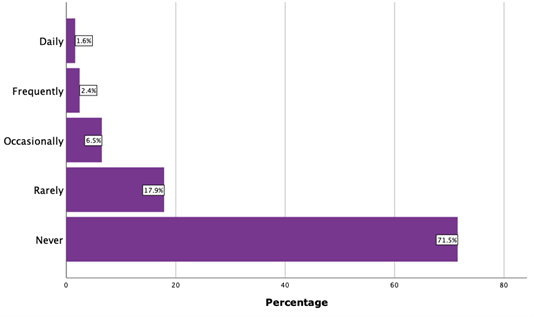(text and background only visible when logged in)
VR/AR-based educational tools have the potential to revolutionize learning for students of all ages and disciplines. In this white paper, the authors share their current study and findings on students' familiarity, experience, and readiness to integrate such technologies into instructional practices.
Recently, Apple's Vision Pro has brought virtual reality (VR) back into the spotlight. However, the concept of virtual reality has been around since 1935 when Stanley Weinbaum, an American science fiction writer, introduced it in his short story Pygmalion's Spectacles (Barnard, 2023). Over the decades, VR has evolved in various forms and found applications in simulating military training environments and providing astronomers with firsthand experiences of tools and environments. While gaming and entertainment currently dominate the use of VR, these technologies hold vast potential in multiple sectors, including business, government, and consumer applications.
VR refers to a computer-generated, three-dimensional environment that users can interact with through a device, such as a head-mounted display (HMD). It can be classified as either non-immersive, where screens surround the user, or immersive, where a wearable display tracks the user's movements and provides a complete 360-degree virtual experience. Immersive VR is the most well-known and marketable form of VR. Augmented reality (AR) falls between immersive and non-immersive VR, overlaying computer-generated imagery onto the real world, such as virtual fitting applications in stores. Mixed reality (XR) combines elements of both AR and VR, allowing users to fully immerse themselves in a virtual world while maintaining a connection to reality (Hamad & Jia, 2022). These interactive experiences utilize various technologies and tools, including booths (e.g., Sensorama), goggles, head-mounted devices, haptic gloves, and stand-alone headsets, to create engaging and immersive virtual environments (Barnard, 2023).
With the continuous advancement of technology and the recent COVID-19 pandemic-related restrictions, VR technologies have found more comprehensive applications in various aspects of daily life and professional settings (Castro, 2020). These technologies now play a significant role in both recreational and work-related activities. They enable people to engage in leisure activities like playing games or visiting museums while also facilitating virtual meetings with colleagues and providing opportunities for collaborating on a project or socializing with friends in a virtual environment.
For instance, VR gaming has seen remarkable progress, with popular titles like Half-Life: Alyx, Horizon: Call of the Mountain, and Beat Saber receiving praise from critics and achieving commercial success. These games offer captivating and interactive experiences that redefine storytelling and gameplay (Smith, 2021). Moreover, VR has expanded beyond gaming into various entertainment domains, such as virtual concerts, immersive theater, and 360-degree films. These experiences provide audiences with unparalleled engagement and unique encounters that traditional media cannot replicate (Dwivedi et al., 2022; Onderdijk et al., 2023).
Subsequently, VR technologies have revolutionized the healthcare industry by providing valuable opportunities for training, diagnostics, and treatment. In training, medical professionals can utilize VR simulations to practice surgeries and procedures in a safe environment, improving their skills and precision. Realistic 3D models and haptic feedback enhance the experience, allowing doctors to effectively develop muscle memory (Limakatso, 2023). In diagnostics, AR tools can overlay vital medical data onto a patient's body, providing clinicians with a comprehensive and intuitive view of the patient's condition. Additionally, VR therapies have shown promise in treating mental health issues like phobias, PTSD, and anxiety disorders (Li, 2022).
Likewise, VR technology is revolutionizing manufacturing and design by simplifying product development and fostering collaboration. Engineers and designers can utilize VR to create and test virtual prototypes, eliminating the need for physical models and saving valuable time and resources (Peek, 2023). The advancements in VR technology are also significantly impacting the retail and marketing sectors. VR/AR-enabled shopping apps allow consumers to virtually try on clothing, accessories, and furniture in the comfort of their homes, boosting their confidence in purchasing decisions and reducing return rates. Virtual showrooms and product demonstrations provide immersive and interactive experiences that captivate potential customers, presenting products in innovative ways. Additionally, location-based VR marketing campaigns deliver personalized and context-aware advertisements, driving customer engagement and fostering brand loyalty (Mileva, 2022; STEngineering, 2019).
All these changes and enhanced expectations have also pushed the boundaries of education, and VRbased or VR-supported instructional designs and implementations have generated great interest from both instructors and students (Kamińska et al., 2019).
VR/AR Technologies in Education
The use of VR/AR as an educational tool is not a new idea. Researchers have been studying the potential of immersive technologies in education since the 1990s (Markowitz et al., 2018). However, it is only in recent years that VR/AR devices and applications have transitioned from experimental prototypes to a mainstream market, with widespread adoption and significant growth (FortuneBusinessInsights, 2019). This transition has been driven by advancements that have made VR/AR more affordable and user-friendly, enabling their practical implementation in classrooms and other educational settings. VR/AR-based educational tools have the potential to revolutionize learning for students of all ages and disciplines. Ongoing research indicates that these tools can enhance learning outcomes from K-12 to higher education settings (Bonasio, 2019). By providing immersive experiences, they offer unique educational opportunities that eliminate the need for extensive travel or resources. Therefore, students can readily embark on virtual visits to distant locations and conduct experiments in a virtual laboratory. Moreover, VR/AR experiences transcend physical limitations, enabling individuals to explore other planets, journey through historical periods, and interact with magnified models of microscopic objects.
These hands-on, gamified approaches to learning actively engage students and support cognitive development, resulting in increased classroom engagement and better retention (Makransky & Mayer, 2022). Also, VR/AR tools improve overall learning outcomes by reducing cognitive load, promoting higher engagement, and enhancing memory recall, particularly in complex subjects like science, technology, engineering, and mathematics (STEM) (Krokos et al., 2019). Furthermore, individual-level immersive learning allows personalized approaches that accommodate different learning styles, speeds, and abilities. The tools also provide feedback to both students and educators, allowing for the adjustment of individual learning objectives to ensure students reach their full potential and minimize the number of students falling behind (Al-Ansi et al., 2023).
In higher education, VR/AR technologies not only replace traditional lecture-style teaching but also have significant value in advanced learning environments, with college and university educators across disciplines incorporating immersive technologies into their courses (Aji & Khan, 2022; Majchrzak et al., 2022). These high-level simulations offer safe and cost-effective alternatives to in-person scenarios while maintaining a high level of immersion. Virtual simulations can significantly reduce costs compared to physical alternatives in fields such as healthcare education, making them particularly valuable for high-cost or high-risk scenarios (Pottle, 2019). Beyond medical education, virtual simulations, as well as augmented learning experiences in higher education, can facilitate soft-skills training, such as negotiation and communication skills (Radianti et al., 2020; Shorey et al., 2020), in-service training settings (Meister, 2021), as well as learning of history, humanities, language, and culture (Shenoy, 2019).
Immersive learning offers significant advantages in career and technical education by providing hands-on experiences that minimize costs and risks associated with field training. For instance, students can gain practical skills by operating and repairing complex machinery through 3D models, allowing them to develop familiarity and safety awareness before working with actual equipment. These immersive tools also equip students with the necessary expertise to effectively utilize emerging technologies in industries like construction and advanced manufacturing, where the adoption of VR/AR and other cutting-edge technologies is on the rise.
Furthermore, VR/AR solutions are crucial in improving research collaboration and hybrid learning models. Immersive environments create opportunities for face-to-face interactions and real-time engagement, regardless of geographical distance. This immersive collaboration helps alleviate fatigue-related challenges during videoconferencing, including cognitive load, restricted mobility, and prolonged eye contact (Dick, 2021). In fully digital settings, participants can interact with virtual objects, including intricate 3D models. Moreover, XR solutions enhance hybrid collaboration and learning models by enabling instructors to communicate with remote students via video chat while simultaneously conducting in-person demonstrations.
Current Study and Its Findings
Considering the benefits and potential use cases of VR/AR technologies, it is clear that the future of instructional practices lies in their implementation. Therefore, our research team aimed to assess the level of familiarity and readiness among college students regarding these technologies and their potential in educational applications. We specifically wanted to understand the students' familiarity, experience, and readiness to integrate such technologies into instructional practices.
Using a convenient sampling approach, we collected data from students affiliated with the Georgia Institute of Technology (Georgia Tech). Georgia Tech is consistently ranked among the top engineering schools in the United States and is internationally recognized for its innovative and interdisciplinary programs. The institution offers a wide range of undergraduate and graduate degree programs across various fields, including engineering, computing, sciences, business, design, and liberal arts.
We conducted an online survey using Qualtrics in late Spring 2023, spanning from the end of April to early May. The survey and study information were made available to all Georgia Tech students through the Canvas learning management system notification service. A total of 164 students agreed to participate in the study, and after excluding incomplete data points, the final dataset consisted of responses from 123 participants. Among these participants, 67% were male, and 28% were female. Approximately half of the participants (54%) were graduate students, with 44% pursuing master's degrees and 10% pursuing doctoral degrees. The remaining 46% were undergraduate students, with 9% being freshmen, 14% sophomores, 14% juniors, and 11% seniors. In terms of the distribution of colleges, 37% of the participants were from the College of Engineering, 36% from the College of Computing, 13% from the College of Science, 6% from the Ivan Allen College of Liberal Arts, 4% from the Scheller College of Business, and 3% from the College of Design.
The survey included a specific question about VR ownership as an indicator of technology acceptance. Among the participants who answered this question, half of them indicated owning a VR headset. Among those who owned a VR headset, 45% reported owning it for 1.5-3 years, while 32% had owned it for 4 or more years. These findings suggest that respondents who own headsets are familiar and experienced with VR technology.
The survey also inquired about participants' awareness of locations, both on and off campus, where they could borrow a VR headset. The analysis revealed that 87% of respondents were not familiar with any on-campus facilities where they could borrow a VR headset, and 86% were not familiar with any off-campus facilities. This highlights a potential gap in access to VR technology and indicates limited options for students to borrow VR headsets for educational or recreational purposes. These results suggest the need for institutions or organizations to consider implementing or promoting VR borrowing programs to enhance accessibility and facilitate broader adoption of VR technology among college students.
Additionally, participants were asked about their familiarity with VR and various VR technologies. Only a small proportion of students (11%) indicated that they were not familiar with VR in general at all (see Figure 1). Indeed, most participants (78%) reported being somewhat familiar or more with VR technologies in general. When it comes to specific VR technologies, many students showed familiarity with Oculus (59%) and desktop VR (49%). However, as shown in Figure 2, 43% of the participants indicated that they were not familiar with Meta Quest.

Figure 1. College Students’ Familiarity with VR in General

Figure 2. College Students’ Familiarity with the Meta Quest Headset
Subsequently, participants were asked about their experiences and familiarity with specific VR activities, including gaming, watching VR videos, and interacting with friends or colleagues via VR. It was found that slightly more than half of the students had limited familiarity or were unfamiliar with watching videos on VR. Among this group, 41% reported never watching VR videos. Similarly, when it came to collaborative activities using VR, 63% of the participants reported never using VR for such activities, and 40% expressed unfamiliarity with this type of interaction. However, the analysis revealed that the majority of participants (64%) reported a moderate to high level of familiarity with playing VR video games. As shown in Figure 3, within this group, half of them indicated engaging in VR gaming occasionally, frequently, or even on a daily basis.

Figure 3. College Students’ Familiarity with Playing Video Games
Furthermore, the researchers investigated the relationship between playing video games and general familiarity with VR. The results revealed a significant but low correlation between playing video games and familiarity with VR in general. Likewise, there was a similar association between the frequency of playing video games and overall VR familiarity. In other words, students who played video games more frequently on PCs, gaming consoles, or other devices tended to have a higher level of familiarity with VR. These findings highlight the potential influence of gaming habits on college students' overall VR familiarity.
Regarding VR in educational settings, as can be seen in Figure 4, a significant majority of participants (71.5%) reported never having experienced VR in an educational context, indicating the need for increased exposure and implementation of VR technology in schools and universities. This suggests a potential gap that needs to be addressed in terms of providing access to VR experiences for educational purposes. Furthermore, 42% of participants expressed unfamiliarity with the utilization of VR for educational purposes, underscoring the importance of educational institutions, administrators, and educators in raising awareness and providing information about the benefits and possibilities of VR in learning environments.

Figure 4. College Students’ Level of Experience in Using VR in Educational Settings
Additional analyses were performed to examine the potential influence of students' fields of study on their experience and familiarity with VR in educational settings. The results demonstrated significant differences between students in the College of Design and those in other colleges, highlighting a significantly greater level of experience and familiarity with VR in educational settings among participants affiliated with the College of Design. However, it is worth noting that similar differences were not observed in terms of experience and familiarity with VR in general, suggesting that the unique focus of the College of Design may contribute to their enhanced expertise in utilizing VR for educational purposes.
On a positive note, a notable number of students (59%) agreed or strongly agreed that learning with VR would be beneficial. This indicates a positive attitude towards incorporating VR into education and suggests that students recognize the potential advantages that VR can offer in enhancing their learning experiences. Moreover, 60% of the participants reported that they would be more excited and engaged in learning if VR was integrated into their educational journey. This highlights the potential of VR to create immersive and captivating learning environments that can foster student motivation and participation.
Additionally, 55% of the participants believed that group work would be more interesting and that there would be increased interaction between peers and instructors with the use of VR. This indicates the social benefits of VR in educational settings and suggests that VR can facilitate collaborative learning experiences and promote effective communication and engagement among students and educators. Furthermore, more than half of the students (63%) believed that learning with VR would help them visualize course content and improve their overall learning performance. This suggests that VR can serve as a powerful tool for enhancing comprehension and retention of knowledge by providing immersive and interactive visual representations. However, it is worth noting that a significant portion of students (46%) expressed caution when it came to the application of knowledge gained through VR to real-world settings. This indicates the need for further exploration and research on how VR experiences can effectively bridge the gap between theoretical learning and practical application. The researchers also examined perceptions of using VR in learning in relation to students' gender, ethnicity, age, and class level. However, the analyses revealed no significant differences among these demographic variables.
Implications and Future Directions
These findings indicate that although students generally have positive attitudes and expectations towards VR educational settings, there is still room for them to fully comprehend and utilize the technology to improve learning performance and effectively transfer newly acquired knowledge or skills to practical settings.
To facilitate and enhance students’ readiness for VR, higher education institutions can begin by establishing places where students can easily borrow VR headsets and other necessary technologies. Making these resources available can ensure equal opportunities for all students to explore and benefit from VR experiences by eliminating the financial barriers that may prevent some students from accessing this technology. Additionally, this initiative allows students to familiarize themselves with VR and integrate it into their learning processes.
However, simply increasing access to the technology will not be sufficient to achieve a satisfactory level of VR readiness. Therefore, higher education institutions can complement their efforts by offering VR courses and workshops in remote and in-person formats, focusing on VR technologies and their applications in various fields, such as 3D modeling, user experience design, and VR content creation. These workshops provide students with practical experience, enabling students to understand the potential of VR in instructional and learning settings.
Furthermore, universities can encourage the integration of VR into existing courses where it can enhance instructional methods and improve student learning outcomes. Instructors can design assignments or projects that require students to create VR content or engage with existing VR applications to practice skills and collaborate with their peers. To enable this integration, faculty development programs and workshops should be implemented to effectively train instructors in the use of VR technologies for teaching. Follow-up meetings or seminars can also be organized to keep them informed about the latest advancements in VR and provide guidance on integrating the latest VR technologies into their instructional practices. These gatherings provide a platform for sharing best practices and success stories, inspiring more educators to adopt VR in their courses.
Additionally, universities can establish collaborations with VR industry partners to create opportunities such as guest lectures, industry-sponsored projects, internships, and joint research initiatives. By connecting students with professionals working in the VR industry, universities can offer valuable insights, mentorship, and networking opportunities that enhance students' familiarity with VR technologies. Moreover, student-led initiatives like VR clubs or organizations can further promote students' familiarity with VR technology and its applications. These initiatives can organize VR-related events, hackathons, or competitions, empowering students to take ownership of their learning and develop leadership skills in the field of VR.
Overall, these approaches enable students to grasp the potential of VR as a valuable learning tool and expose them to practical applications in real-world scenarios. By focusing on these areas, educational institutions can harness the advantages of VR technology and enrich the learning experience for their students. Additionally, it would be valuable to conduct further studies to investigate the readiness of VR in online learning, professional development, and workplace learning settings. This would provide valuable insights into the effectiveness and applicability of VR in diverse educational contexts beyond the traditional classroom environment.